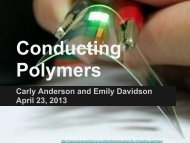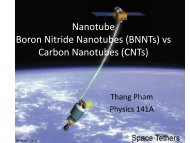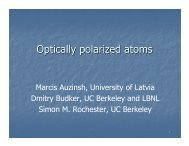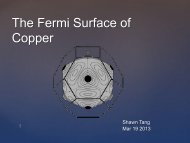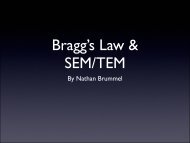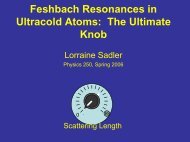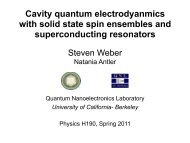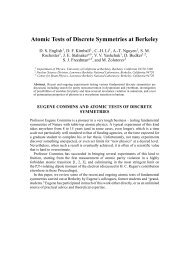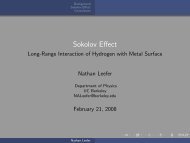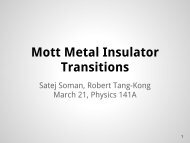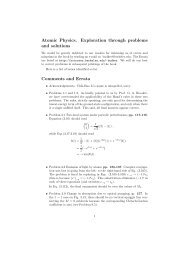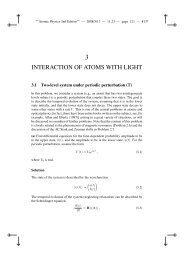Resonant nonlinear magneto-optical effects in atomsâ - The Budker ...
Resonant nonlinear magneto-optical effects in atomsâ - The Budker ...
Resonant nonlinear magneto-optical effects in atomsâ - The Budker ...
You also want an ePaper? Increase the reach of your titles
YUMPU automatically turns print PDFs into web optimized ePapers that Google loves.
31<br />
quence, no high-resolution <strong>magneto</strong>-<strong>optical</strong> spectra have<br />
been recorded <strong>in</strong> such matrices. However, the quantum<br />
nature (large amplitude zero-po<strong>in</strong>t motion) of a condensed<br />
helium matrix makes it extremely compressible,<br />
and a s<strong>in</strong>gle-valence-electron guest atom can impose its<br />
symmetry on the local environment via Pauli repulsion.<br />
Alkali atoms thus form spherical nanometer-sized cavities<br />
(atomic bubbles), whose isotropy, together with the<br />
diamagnetism of the surround<strong>in</strong>g He atoms, allows longlived<br />
sp<strong>in</strong> polarization to be created <strong>in</strong> the guest atoms<br />
via <strong>optical</strong> pump<strong>in</strong>g. With Cs atoms <strong>in</strong> the cubic phase<br />
of solid He, longitud<strong>in</strong>al sp<strong>in</strong> relaxation times T 1 of 1 s<br />
were reported by Arndt et al. (1995), while transverse<br />
relaxation times T 2 are known to be larger than 100<br />
ms (Kanorsky et al., 1996). <strong>The</strong> T 1 times are presumably<br />
limited by quadrupolar zero-po<strong>in</strong>t oscillations of the<br />
atomic bubble, while the T 2 times are limited by magnetic<br />
field <strong>in</strong>homogeneities. In superfluid He, the coherence<br />
life times are limited by the f<strong>in</strong>ite observation time<br />
due to convective motion of the paramagnetic atoms <strong>in</strong><br />
the He matrix (K<strong>in</strong>oshita et al., 1994).<br />
Nonl<strong>in</strong>ear <strong>magneto</strong>-<strong>optical</strong> level-cross<strong>in</strong>g signals (the<br />
longitud<strong>in</strong>al and transverse ground-state Hanle <strong>effects</strong>)<br />
were observed by Arndt et al. (1995); Weis et al. (1995)<br />
as rather broad l<strong>in</strong>es due to strong magnetic-field <strong>in</strong>homogeneities.<br />
In recent years, sp<strong>in</strong>-physics experiments<br />
<strong>in</strong> solid helium have used (radio-frequency/microwave–<br />
<strong>optical</strong>) double resonance techniques. Optical and<br />
<strong>magneto</strong>-<strong>optical</strong> studies of defects <strong>in</strong> condensed helium<br />
were reviewed by Kanorsky and Weis (1998).<br />
Applications of sp<strong>in</strong>-polarized atoms <strong>in</strong> condensed helium<br />
<strong>in</strong>clude the study of the structure and dynamics of<br />
local trapp<strong>in</strong>g sites <strong>in</strong> quantum liquids/solids, and possible<br />
use of such samples as a medium <strong>in</strong> which to search for<br />
a permanent atomic electric-dipole moment (Weis et al.<br />
(1997); Sec. XII.B).<br />
H. Laser-cooled and trapped atoms<br />
Recently, atomic samples with relatively long sp<strong>in</strong>relaxation<br />
times were produced us<strong>in</strong>g laser-cool<strong>in</strong>g and<br />
trapp<strong>in</strong>g techniques. When study<strong>in</strong>g NMOE <strong>in</strong> trapped<br />
atoms, one must take <strong>in</strong>to account the perturbation<br />
of Zeeman sublevels by external fields (usually magnetic<br />
and/or <strong>optical</strong>) <strong>in</strong>volved <strong>in</strong> the trapp<strong>in</strong>g technique.<br />
Atoms can be released from the trapp<strong>in</strong>g potentials before<br />
measurements are made <strong>in</strong> order to elim<strong>in</strong>ate such<br />
perturbations. 31<br />
<strong>The</strong>re have been several recent studies of the Faraday<br />
31 Another po<strong>in</strong>t to consider is that Doppler broaden<strong>in</strong>g due to the<br />
residual thermal velocities of trapped atoms is smaller than the<br />
natural l<strong>in</strong>e width of the atomic transition. <strong>The</strong>refore, <strong>in</strong> the<br />
low-power limit, <strong>optical</strong> pump<strong>in</strong>g does not lead to formation of<br />
Bennett structures (Sec. V.A) narrower than the width of the<br />
transition.<br />
and Voigt <strong>effects</strong> us<strong>in</strong>g <strong>magneto</strong>-<strong>optical</strong> traps (MOTs).<br />
Isayama et al. (1999) trapped ∼10 8 85 Rb atoms <strong>in</strong> a<br />
MOT and cooled them to about 10 µK. <strong>The</strong>n a pump<br />
beam was used to sp<strong>in</strong>-polarize the sample of cold atoms<br />
orthogonally to an applied magnetic field of ∼2 mG. Larmor<br />
precession of the atoms was observed by monitor<strong>in</strong>g<br />
the time-dependent polarization rotation of a probe<br />
beam. <strong>The</strong> limit<strong>in</strong>g factor <strong>in</strong> the observation time (∼11<br />
ms) for this experiment was the loss of atoms from the region<br />
of <strong>in</strong>terest due to free fall <strong>in</strong> the Earth’s gravitational<br />
field. Labeyrie et al. (2001) studied <strong>magneto</strong>-<strong>optical</strong> rotation<br />
and <strong>in</strong>duced ellipticity <strong>in</strong> 85 Rb atoms trapped and<br />
cooled <strong>in</strong> a MOT that was cycled on and off. <strong>The</strong> Faraday<br />
rotation was measured dur<strong>in</strong>g the brief time (∼8 ms) that<br />
the trap was off. <strong>The</strong> time that the MOT was off was sufficiently<br />
short so that most of the atoms were recaptured<br />
when the MOT was turned back on. Franke-Arnold et al.<br />
(2001) performed measurements of both the Faraday and<br />
Voigt <strong>effects</strong> (Sec. I) <strong>in</strong> an ensemble of cold 7 Li atoms.<br />
Optical rotation of a weak far-detuned probe beam due<br />
to <strong>in</strong>teraction with polarized atoms was also used as a<br />
technique for non-destructive imag<strong>in</strong>g of Bose-E<strong>in</strong>ste<strong>in</strong><br />
condensates (as <strong>in</strong> the work of, for example, Matthews,<br />
1999).<br />
Narducci (2001) has recently begun to explore the possibility<br />
of measur<strong>in</strong>g NMOE <strong>in</strong> cold atomic founta<strong>in</strong>s.<br />
<strong>The</strong> experimental geometry and technique of such an<br />
experiment would be similar to the setup for Faraday-<br />
Ramsey spectroscopy described <strong>in</strong> Sec. VIII.C, but the<br />
time-of-flight between the pump and probe regions could<br />
be made quite long (a few seconds).<br />
With far-off-resonant blue-detuned <strong>optical</strong> dipole<br />
traps, one can produce alkali vapors with ground-state<br />
relaxation rates ∼0.1 Hz [for example, Davidson et al.<br />
(1995) observed such relaxation rates for ground-state<br />
hyperf<strong>in</strong>e coherences]. Correspond<strong>in</strong>gly narrow features<br />
<strong>in</strong> the magnetic-field dependence of NMOE should be<br />
observable. However, we know of no experiments <strong>in</strong>vestigat<strong>in</strong>g<br />
NMOE <strong>in</strong> far-off-resonant <strong>optical</strong> dipole traps.<br />
IX. MAGNETO-OPTICAL EFFECTS IN SELECTIVE<br />
REFLECTION<br />
1. L<strong>in</strong>ear <strong>effects</strong><br />
<strong>The</strong> standard detection techniques <strong>in</strong> atomic spectroscopy<br />
are the monitor<strong>in</strong>g of the fluorescence light and<br />
of the light transmitted through the sample. A complementary,<br />
though less often used technique is monitor<strong>in</strong>g<br />
the light reflected from the sample or, more precisely,<br />
from the w<strong>in</strong>dow-sample <strong>in</strong>terface. <strong>The</strong> reflected light <strong>in</strong>tensity<br />
shows resonant features when the light frequency<br />
is tuned across an atomic absorption l<strong>in</strong>e (Cojan, 1954).<br />
<strong>The</strong> technique was discovered by Wood (1909) and is<br />
called selective reflection spectroscopy. A peculiar feature<br />
of selective reflection spectroscopy was discovered<br />
after the advent of narrow-band tunable lasers: when the



